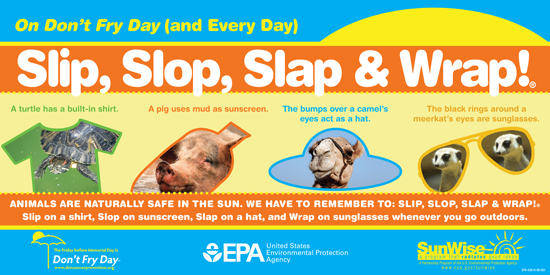UV Monitors, Sunscreen Pills & Drinkable Sunscreen – Do They Work?

On “Don’t Fry Day” (and Every Day), Slip, Slop, Slap & Wrap! From Wikimedia Commons free media repository, licensed by The U.S. National Archives Catalog.
Amid recent headlines about how most of us fail to wear sunscreen comes news about more sunscreen products that we can blow off and — oh, wait, uh . . . maybe not: these new products sound pretty cool . . .
A Sunscreen Pill?
Believe it or not, there’s evidence that popping a pill could offer at least some protection against the UV rays.
One of the most popular products is called Heliocare; it contains an ingredient, Polypodium leucotomos, an extract of a Central American fern plant that has been observed to increase the skin’s resistance to sunburn in some clinical studies [ ((El-Haj N, Goldstein N. Sun protection in a pill: the photoprotective properties of Polypodium leucotomos extract. Int J Dermatol. 2015 Mar;54(3):362-6))].
Another popular product called BioAstin, containing astaxanthin, a chemical compound extracted from algae, has also been observed in some clinic studies to help protect the skin against sunburn [ ((Clinical Trial Indicates Sun Protection from BioAstin Supplement. Cyanotech Corporation))].
But do these sunscreen pills offer sufficient protection against UV rays? Dr. Lim, board-certified dermatologist, cautions that those studies which found support for the idea of a sunscreen pill also found that they offered only a 3-5 SPF level of protection, significantly less than the 30 SPF or more level of protection recommended by the American Academy of Dermatology [ ((Could protecting your skin from the sun be as easy as popping a pill? AAD.Org, CHICAGO, Ill. (Aug. 7, 2014))].
Says Dr. Lim, “if someone wants to take a sunscreen pill, they should continue protecting their skin by seeking shade, wearing protective clothing, and applying sunscreen.”
UV (Ultraviolet) Light Monitoring
Even for those of us who do use sunscreen, there is the issue of when we should use it and how often. Ideally, we’d like to expose our skin long enough to the sun to get the health benefits of vitamin D production but not so long that we get burned [ ((Mead N. Benefits of Sunlight: A Bright Spot for Human Health. Environ Health Perspect. 2008 Apr; 116(4): A160–A167))].
One solution is a UV monitor that estimates both vitamin D production and the amount of UV our skin is absorbing.
The good news is that several products purport to do just that.
One product, Violet, monitors both your vitamin D production and UV exposure and tells you when it’s time to put on sunscreen; Violet will also tell you when to reapply it. Uveband, a cool, self-charging, solar-powered wrist band, and Sunfriend, another wrist band, will also monitor your UV exposure and tell you when to reapply sunscreen. Finally, Netatmo’s June does pretty much what these other UV monitors do, but it tries to disguise itself as an expensive piece of jewelry.
But do these UV monitors really work?
“Personal UV-monitoring is an interesting development. It could help increase awareness of the need for sun protection by the general public,” said Dr. Lim. However, he cautions consumers to be wary of their reliability: “are UV levels constantly measured? How reliable is it if a person is in an area without cellular or Internet access? Is the product ready for prime time? It is promising, but I’m not sure we are at that stage yet.” [ ((Could protecting your skin from the sun be as easy as popping a pill? AAD.Org, CHICAGO, Ill. (Aug. 7, 2014))].
Drinkable sunscreen
Yes, you read that right: in addition to the sunscreen pill, there’s also – apparently – sunscreen you can drink.
How does it work? According to the manufacture of the only drinkable sunscreen on the market, Osmosis Skincare, it works to protect against sunburn because it “[the water] contains standing waves (scalar waves) that have a cancellation effect on UV radiation.”
Does it Work?
